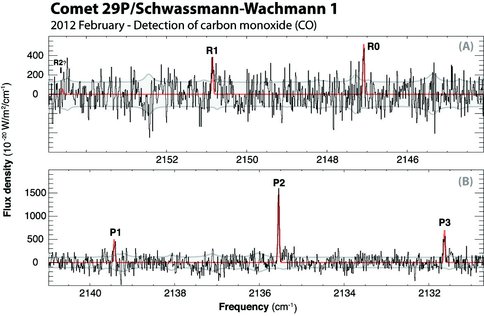2012 Annual Science Report
 NASA Goddard Space Flight Center
Reporting | SEP 2011 – AUG 2012
NASA Goddard Space Flight Center
Reporting | SEP 2011 – AUG 2012
Summary of Research Accomplishments for L. Paganini
Project Summary
Dr. Lucas Paganini has performed astronomical observations of six comets that led to four publications in peer-reviewed journals (namely, two papers as first author and two as co-author). In July 2011 he (and colleagues) discovered that comet C/2009 P1 (Garradd) is CO-rich. And in 2012 he (and colleagues) detected carbon monoxide in a comet beyond Jupiter (at 6.26 AU from the Sun), thus setting a new record for detections by infrared (IR) spectroscopy of parent volatiles in comets at relatively large heliocentric distances. Until now considered to be a somewhat impossible task with IR ground-based facilities, these discoveries open up new opportunities for targeting multiple volatile species at low rotational temperatures, as well as the unique possibility to characterize hypervolatiles in distant comets.
Project Progress
During this period as NASA Postdoctoral Fellow, Dr. Lucas Paganini achieved the following goals:
- He performed astronomical observations of 6 comets: 45P/H-M-P, 78P/Gehrels, 255P/Levy, 29P/Schwassmann-Wachmann 1, C/2009 P1 (Garradd), and C/2011 L4 (PanSTARRS). He has played a key role in planning and performing the observations, as well as in the analysis of these data.
- He characterized the chemical taxonomy of comets 103P/Hartley 2 (where he served as co-author on one Icarus paper), 10P/Tempel 2 (where he collaborated with the astronomical observations and served as first author on one Icarus paper), and C/2009 P1 (Garradd) (where he and colleagues demonstrated that Garradd is a CO-rich comet, and served as *first author on one ApJ Letters paper, one IAU Circular, and as co-author on one Icarus note).
- In February 2012, Dr. Paganini and colleagues detected for the first time several carbon monoxide (CO) emission lines in a comet at 6.26 AU from the Sun (i.e., beyond Jupiter) using Infrared Spectroscopy. These detections were confirmed through granted Director Discretionary Time (DDT; PI: Paganini) observations with ESO’s Very Large Telescope using CRIRES in May 2012. This discovery opens up new opportunities for targeting volatile species at low rotational temperatures in distant comets.
- Dr. Paganini developed a model for carbon monoxide that includes excitation processes and radiative transfer in the coma, including neutral-neutral collisions, radiative pumping by solar radiation (both ro-vibrational and direct rotational pumping), as well as direct rotational pumping from the cosmic microwave background (CMB).
- Dr. Paganini presented papers at the EPSC-DPS Joint Meeting 2011 (Nantes, France), Astrobiology Science Conference 2012 (Atlanta, Georgia), Asteroids, Comets, Meteors 2012 (Niigata, Japan), and the Max Planck Institute (Germany; invited). He also collaborated in several other presentations in these conferences by other team members.
- He has worked on and improved analysis tools and pipelines for data processing of infrared observations by our group.
Figure 1. Emission spectra of CO (fundamental band, v = 1–0) in 29P/Schwassmann-Wachmann 1, on UT 2012 February 26–29. (A) Detections of R1 and R2 emission lines in CRIRES, detector 2. (B) Detections of P1, P2, and P3 in CRIRES, detector 3. In panels A and B, the continuous (underlying) red line depicts the modeled spectra.
Publications
-
Paganini, L., Mumma, M. J., Bonev, B. P., Villanueva, G. L., DiSanti, M. A., Keane, J. V., & Meech, K. J. (2012). The formation heritage of Jupiter Family Comet 10P/Tempel 2 as revealed by infrared spectroscopy. Icarus, 218(1), 644–653. doi:10.1016/j.icarus.2012.01.004
-
Paganini, L., Mumma, M. J., Villanueva, G. L., DiSanti, M. A., Bonev, B. P., Lippi, M., & Boehnhardt, H. (2012). THE CHEMICAL COMPOSITION OF CO-RICH COMET C/2009 P1 (GARRADD) AT R h = 2.4 and 2.0 AU BEFORE PERIHELION. The Astrophysical Journal, 748(1), L13. doi:10.1088/2041-8205/748/1/l13
-
Villanueva, G. L., Mumma, M. J., DiSanti, M. A., Bonev, B. P., Paganini, L., & Blake, G. A. (2012). A multi-instrument study of Comet C/2009 P1 (Garradd) at 2.1AU (pre-perihelion) from the Sun. Icarus, 220(1), 291–295. doi:10.1016/j.icarus.2012.03.027
-
PROJECT INVESTIGATORS:
-
PROJECT MEMBERS:
Lucas Paganini
Collaborator
-
RELATED OBJECTIVES:
Objective 1.1
Formation and evolution of habitable planets.
Objective 3.1
Sources of prebiotic materials and catalysts
Objective 3.2
Origins and evolution of functional biomolecules
